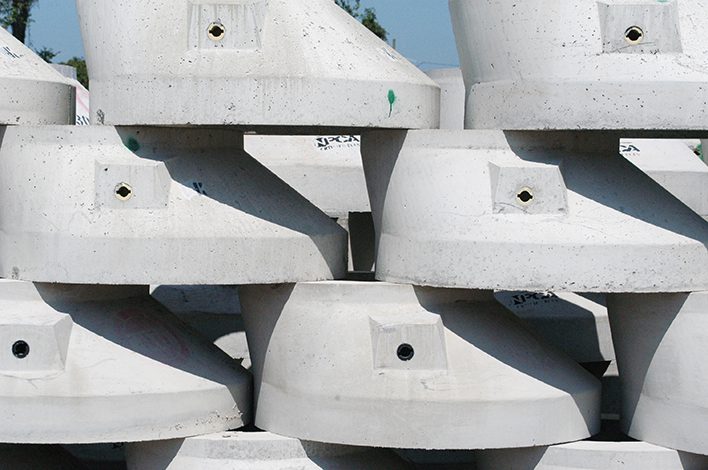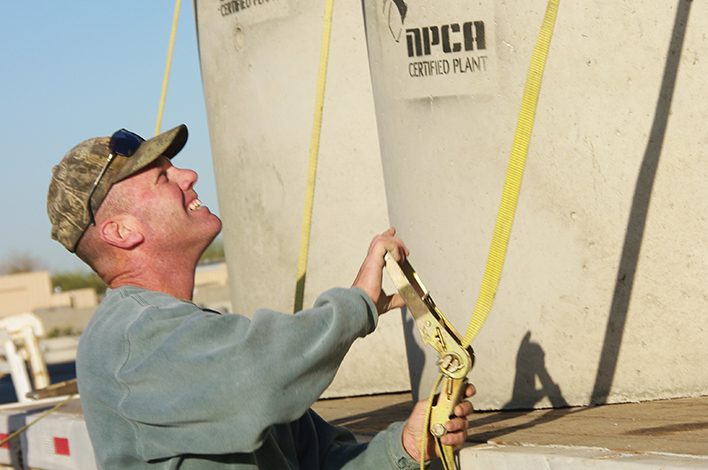Alternative materials are trying to make inroads into the precast manhole market, but precast concrete remains the standard
Underneath the ground, hidden from view, lies a vast network of utility systems. Sewer lines, storm water systems and electrical utilities stretch nationwide.
Connecting us to those underground networks are approximately 22 million manholes, providing access needed for utility inspections and maintenance to keep cities running efficiently.
Since the 1850s, concrete has been the mainstay building material for manholes. The most common usage of precast manholes is for sanitary sewer and stormwater conveyance, carrying wastewater to sewer treatment plants and rainwater to retention structures. Precast also is commonly used for concrete storage bunkers, lift stations and utility access.
According to the Environmental Protection Agency, approximately 5.5 million manholes currently need repairs, and new infrastructure projects continue to come in on the federal, state and local levels.
Alternative material manufacturers are making some bold claims when it comes to what their products are expected to do. However, precasters can say with certainty – with a century and a half of examples to point out – exactly how precast concrete is the best fit for every job.
HOW THE COMPETITION’S SHAPING UP
Manholes constructed from alternative materials include brick and stone, cast-in-place concrete, fiberglass, fiberglass reinforced concrete (FRC) and plastics such as high-density polyethylene (HDPE) and polyvinyl chloride (PVC). What is available depends on the location.
In the South, especially Florida and Texas, it is HDPE, other plastics and fiberglass, all relatively new materials for this type of construction.
These newer materials are aggressively marketing their manhole products. In the areas these companies have targeted, precasters face competition.
“Typically, concrete manholes are the backbone of the underground sewer systems of any municipality and alternative products are the relative newcomer being used in limited circumstances, but (alternative materials) are always encroaching into the market with untested and unproven claims,” said Leo Feuerstein, operations manager of Western Precast Concrete, based in El Paso, Texas.
Feuerstein sees stiff competition from fiberglass, and resin- or petroleum-based plastics in smaller sizes of round manholes used in the sanitary sewer sector.
“Their industry has promoted their products as being superior in fighting against sewer gasses and microbial-induced corrosion,” he said.
The most common claims are based on outdated studies and ignore advancements in precast concrete manufacturing, Feuerstein said.
If effluent from a sewer system doesn’t move waste through fast enough, the waste can generate sewer gas (mainly hydrogen sulfide and carbon dioxide) that can degrade concrete and corrode steel reinforcement. This issue most often occurred in past decades in flat terrain areas.
Modern anti-microbial additives and coatings for concrete now make this a non-issue.
“Additives and coatings are cost-effective insurance against corrosion that doesn’t drive the cost of a precast item anywhere near the cost of a polymer or HDPE structure,” said Ron Sparks, CEO and partner of National Precast, based in Vancouver, Wash.
Feuerstein agrees.
“Concrete products with the proper admixtures and coatings not only provide strength and durability but provide proven performance against deterioration from external forces such as sewer gas,” he said.
This is the narrative against alternative material claims.
THE SUPERIORITY OF PRECAST
Here are some of the many advantages precast has over alternative products.
Quality
“First and foremost is the quality control that goes into each manhole produced in a controlled environment,” Feuerstein said. “Wall thickness, concrete strength, reinforcement and all other aspects of production are monitored to conform to ASTM C-478 specifications, the national standard.”
Sparks said that when he was with Columbia Precast Products in Woodland, Wash., the deviation from the mix design to the actual produced mix was less than 0.05% over 40,000 batches. This is a distinct advantage over alternative methods such as cast-in-place in terms of precision, uniformity and quality.
Cost-effectiveness
Being constructed offsite and in bulk allows specifiers to get the most out of their dollars in precast concrete.
“You burn a lot of labor into building one cast-in-place manhole when you could build 20 or 30 precast manholes in the same timeframe,” said Clark Simmons, technical services manager at MBO Precast, based in Carver, Mass.
Fiberglass, HDPE, PVC and other plastic manholes also are more costly compared to precast concrete. On some projects, Feuerstein has seen the cost of alternative products come in at three times the cost of precast.
It’s not just a matter of the initial cost to the project owner, either. When a Florida municipality ruled concrete unacceptable for its sanitary sewer manholes four years ago, the local Home Builders Association showed the municipality that using alternative materials increased the final cost by 30% for each lot.
Within 45 days, concrete was reinstated to the municipality’s list of accepted materials.
Ease of Installation
“Precast is quicker to install and less labor-intensive,” said Dennis Morrissey, executive vice president of Foley Products, headquartered in Newnan, Ga. “You may need three workers to install cast-in-place versus two for precast.”
Morrissey said corrosion-resistant HDPE liners, which some agencies now request, are easily installed at the plant but not in the field.
Fiberglass, HDPE and other plastic alternative materials also present installation issues. A 24-inch precast manhole weighs about 2,800 pounds while a 24-inch fiberglass manhole weighs about 280 pounds, making it difficult and time-consuming to stack the manhole components and keep them level. Unlike precast, fiberglass requires fabric slings or other special equipment to protect it from damage during installation.
“Using alternative materials slows things down,” Sparks said. “Precast manholes are heavy enough that they can stack vertically and stay level. The installer can begin backfilling around it immediately.”
With a specific gravity of 2.4 and a powerful resistance to friction, precast concrete manholes are better able to resist the buoyant forces associated with underground construction.
“Fiberglass and HDPE have specific gravities of 1.86 and 0.97 respectively, so they require tie-downs or concrete placements, concrete bases and covers and precast does not,” Simmons said. “This leads to more cost and carbon emissions.”

High Adaptability
Triangles, squares, rounded … precast concrete molds to obtain most any shape a customer desires.
“Your dream and imagination is our only limit,” Morrissey said.
Precast concrete accommodates manhole sizes ranging from 24 inches to 144 inches and most any internal piping configuration.
Precast’s adaptability lends itself to more creative functions.
Simmons said he once worked on a project where a precast manhole was painted to look like a buoy that marks the southernmost part of the continental United States. Another project used two concrete-filled precast manholes to anchor a banner advertising the Miami Super Bowl that spanned a four-lane highway. Both jobs were completed when he worked at U.S. Precast in Hialeah, Fla.
Speedy Availability and Delivery
The No. 1 advantage of precast for Sparks is speed of delivery.
“Most precasters make stock products, then modify them for specific projects,” Sparks said. “Once we have an approved drawing, it’s typically a two- to four-day turnaround, while delivery of alternative material products sometimes takes weeks or months.”
Polymer manholes ship from three sites: Texas, Arizona and Utah. Customers may have to fill a truckload to place an order, and orders are required weeks or even months in advance.
“Anybody who’s running a utility project knows there’s changes – elevation changes, pipe changes, etc.,” Feuerstein said. “That unfriendly delivery schedule can cause a lot of problems.”
Strength and Durability
Precast manholes can be designed to meet H-20 heavy traffic requirements (up to 32,000 pounds per axle load). The load-bearing capacity for traffic and exterior soils comes from its inherent structural capacity.
Alternative products require concrete structures at the base and slab to achieve similar load requirements.
Precast concrete will not rust, rot or burn. Simmons said that at 200 degrees F, fiberglass will lose its structure, and plastic will melt and burn. This is relevant with the increased number of reported wildfires across North America.
HDPE becomes brittle and can break when exposed to UV radiation such as in sunlight. Fiberglass also is susceptible to sunlight and moisture and needs to be coated to prevent expansion and decay.
Precast concrete, with a proven life span of 100-plus years, is one of the most durable construction materials.
“Other materials may say that, but they can’t really prove it in the real world,” Sparks said. “The question I always ask people is: Why would you risk using a product that isn’t proven or that doesn’t have some of the qualities that a precast structure does? Manholes are a major part of our infrastructure, and they have to last and be structurally sound.”
Sustainability
“There’s nothing more green or earth friendly than concrete,” Feuerstein said. “Concrete manholes are produced using locally sourced natural materials – rock, sand and other core materials – that typically come directly from the earth.”
Concrete can be recycled indefinitely, leaving nothing behind to harm the soil.
In contrast, plastics are not eco-friendly. HDPE is produced using petroleum, and PVC is produced by a chemical reaction between chloride, carbon and ethylene. It releases harmful chemicals into the environment during production. Plus, it takes plastics 450 years to decompose.
Fiberglass is considered eco-friendly, but like HDPE and other plastics, it, too, typically must be trucked a far distance to the customer, using more petroleum. Precast concrete, by comparison, is locally sourced, shaped and shipped.
“In nine cases out of 10, when you buy concrete you’re supporting the local economy, local employees and reducing the carbon footprint,” Sparks said.
